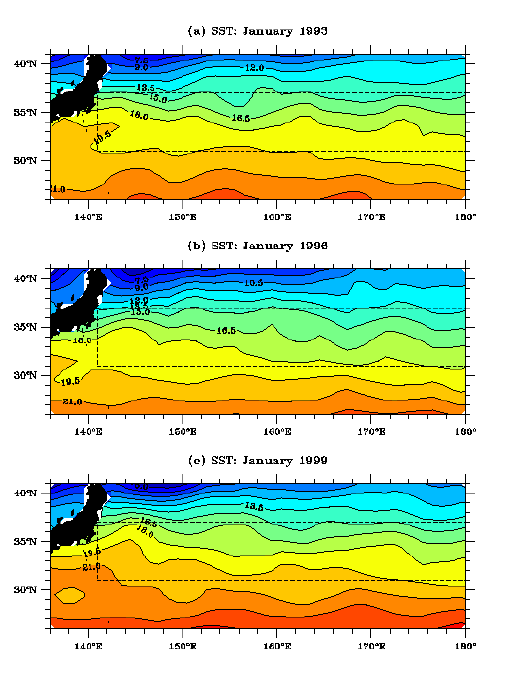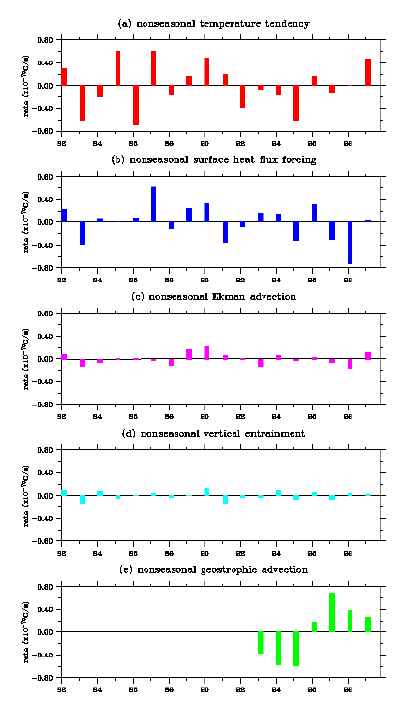
On interannual timescales,
warm (cold) wintertime SST anomalies in the Kuroshio Extension region tend
to coincide with the northerly (southerly) paths of the Kuroshio Extension
SST in North Pacific
Wintertime SST anomalies in the Kuroshio Extension and
mean zonal position of the Kuroshio Extension
The effect of interannual variability of the Kuroshio Extension on the wintertime SST anomaly field is assessed by examining the heat balance in the surface ocean mixed layer.
Interannual signals associated
with the Kuroshio Extension system are mostly independent of the ENSO-related
tropical variability.
Correlation between wintertime SST anomaly in the Kuroshio
Extension and the North Pacific Ocean
Kuroshio Extension was more
intense and its path more northerly in 1992 and 1998, the wintertime SST
in the Kuroshio Extension Region is warmer.
SST in the Kuroshio Extension
Region was cold in Jan 1996, when surface transport of the Kuroshio Extension
was weak and its zonal mean path was relatively southerly.
Sea surface temperature fields in January of (a) 1993, (b) 1996, and (c) 1999 from the 1° -gridded SST data set of NCEP. Note that SST in the Kuroshio Extension region (dashed box) is colder in 1995 than in 1992 and 1998.
On interannual timescales,
warm (cold) wintertime SST anomalies in the Kuroshio Extension region tend
to coincide with the northerly (southerly) paths of the Kuroshio Extension
(a) Time series of the wintertime SST anomalies averaged in the Kuroshio
Extension region (31° -37° N, 141° E--180°). (b) Time series
of the mean axis position of of the Kuroshio Extension from 141 °E
to 180 °. The axis data are from both the Geosat ERM period of late
1980s and the recent T/P period. Warm (cold) wintertime SST anomalies tend
to persist in years when the Kuroshio Extension is in its elongated (contracted)
state.
Temperature tendency, surface heat flux forcing, Ekman advection, and vertical entrainment will not close the mean surface ocean heat balance.
During 1982-1999, the sum of surface heat flux forcing Ekman advection and vertical entrainment overestimates surface cooling.
The warming effect of geostrophic
advection offsets the "excessive" cooling.

The nonseasonal geostrophic
advection was negative in 1993-1995 when the intensity of the Kuroshio
Extension had a decreasing
Time series of the nonseasonal values for the terms in the surface ocean heat equation. The J/F/M mean values for each term is listed in Table 1.
Wintertime SST anomalies
in the Kuroshio Extension are highly correlated with wintertime SST anomalies
in the Kuroshio Extension region downstream of the Shatsky Rise.
Japan and the Izu Ridge act
a meridional barrier along 141° E and induce local SST changes that
are different from SST changes associated with large-scale Kuroshio Extension
Interannual SST signals associated
with the Kuroshio Extension system have only weak corresponding signals
in the tropical Pacific Ocean.
Linear correlation coefficient between the wintertime SST anomaly time series of the Kuroshio Extension region and the wintertime SST anomaly time series at each 1° grid of the equatorial and North Pacific Ocean.

|





|